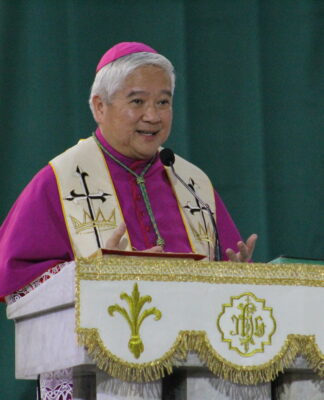SO YOUNG yet so forlorn. Antonnette Llanera from Bicol saw her days becoming dimmer and dimmer because of a serious ailment.
Llanera was diagnosed with myopathy, a degenerative disease of the muscle cells, which caused her left leg to shrink and her life to wane. At that point, the girl needed a miracle.
But miracles do happen. Llanera’s doctors found out that the strength of both her legs was not affected. More important, the illness would not cost her her life.
Llanera’s medical miracle was attributed to the “healing priest,” Fr. Fernando Suarez. In a public testimonial, Llanera’s mother said the findings were taken after her daughter had witnessed one of Suarez’s healing sessions on television. Without any reservation, Llanera’s relatives pointed to the recovery as having been caused by “divine intervention.”
The healing ministry of Suarez has captured the public’s imagination. But there have also been criticisms and feedbacks on Suarez’s “gift.”
Fr. Virgilio Ojoy, O.P., professor at the UST Ecclesiastical Faculties, said that the work of Suarez has been sensationalized.
“The seriously sick and even the dying add insult to their injury by waiting for long hours sometimes under the cruelest conditions just to be touched by him,” Ojoy wrote in his essay, To Heal or Not to Heal: What is the Answer?. “It is in this sense that the faithful need to be educated.”
The Church recognizes that there are gifted individuals who have received special charisms. The Church also suggests that healing is also possible through the prayers of any priest or bishop.
According to the Congregation of the Doctrine of the Faith, only those with a theological degree can perform the anointment of the sick except in special cases.
“The rituals of the Sacrament of the Anointing of the Sick have always presumed that the minister of the Sacrament be either a bishop or a priest,” the Vatican agency says in its Notes on the Minister of the Sacrament of the Anointing of the Sick. “However in regions in which the shortage of priests makes it difficult to administer the Sacrament, permanent deacons and even qualified lay people could be delegated to administer the Sacrament.”
The Catholic Bishops Conference of the Philippines has yet to make a stand on Suarez’s alleged cures.
“The Catholic bishops’ leadership does not have any position yet regarding the faith healings of Suarez,” Bulacan Bishop Jose Francisco Oliveros said in a press conference. “Whether the person (Suarez) is an instrument of God for healing, that is still to be determined.”
Batangas-born Suarez was a graduate of Chemical Engineering in Adamson University before he went to Canada, where he decided to pursue his vocation. In 1997, he joined the religious community, Companions of the Cross. Five years later, he was ordained as a priest.
Earlier in 1996, Suarez began to give small stipends to poor Filipino children. Later on, after he became a priest, the charity work paved the way for the formation of the Mary Mother of the Poor Foundation.
Today, the charitable foundation supports thousands of poor Filipinos through scholarships, feeding programs, medical missions, and housing projects.
Dose of faith
Faith healing, an unconventional method of curing the sick, features spiritual intercessions, mental practices, and ceremonies. It provides supernatural cures for patients.
Like other medicines prescribed by doctors, this kind of method is believed by some to give the patient a gradual relief or an immediate and total cure from diseases.
Historians and anthropologists said that even before the coming of the colonizers, the ancient Filipinos were performing natural healings, which continue to be patronized by Filipinos up to now.
According to Anthony Calibo, program manager of the Philippine Medical Tourism, the Department of Health recognizes alternative methods of medication.
“Aside from conventional medical treatments, God and his divine will, which helps patients to recover, cannot be disregarded,” Calibo said during the 15th UST postgraduate course in bioethics last Feb. 8, in UST. In fact, the government encourages the development of alternative traditional treatments for diseases, which include faith healing. With Republic Act 8423, aptly named Traditional and Alternative Medicine Act of 1997, experts are tasked to improve unconventional cures through research.
However, Calibo reminded that sufficient education must be given to people for them to have the proper perspective for these kinds of treatment.
Side effects
Although faith healing is regarded possible through the intervention of God, there is still danger in it, as Catholic spritual theology warns that some miraculous healings may be caused by the “devil.”
According to Fr. Jose Francisco Syquia, director of the Archdiocese of Manila’s Office of Exorcism, the devil may sometimes deceive people by performing seemingly good deeds.
“Not all healing powers that we see come from God,” Syquia said in a seminar titled “Sanib,” held last Feb. 8 at the Thomas Aquinas Research Center Auditorium. “It may be the doing of an evil spirit to redirect our faith”
Syquia said that men should put Christ at the center of their lives.
The Vatican has issued rules to govern Catholic healing rituals (see sidebar).
In his encyclical, Redemptoris Missio, Pope John Paul II said that miraculous healings clearly show Christ’s great compassion despite the sins of men.
“Healings signify that in the kingdom there will no longer be sickness or suffering, and that the mission, from the very beginning, is meant to free people from evil,” the late Pope wrote. “By performing acts of healing, Christ invites people to faith, conversion and the desire for forgiveness.”
















